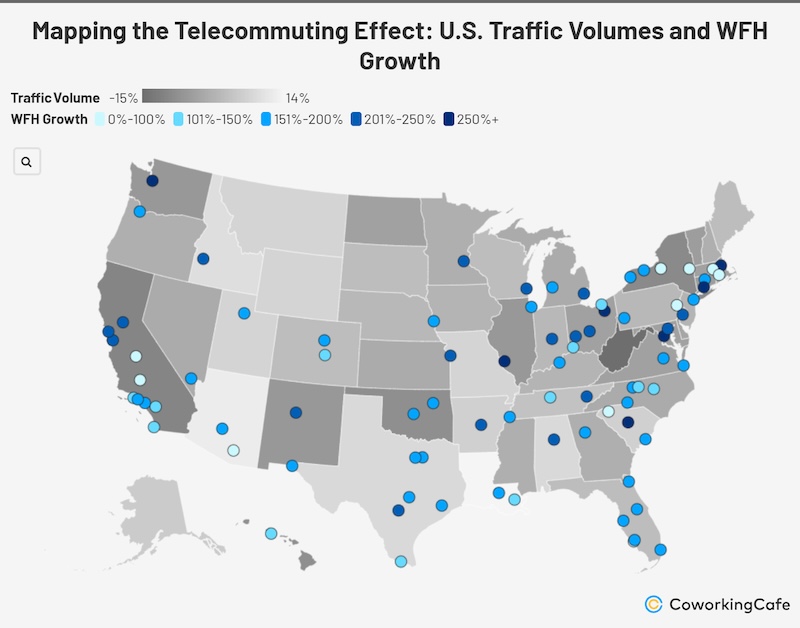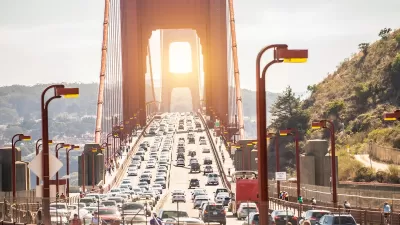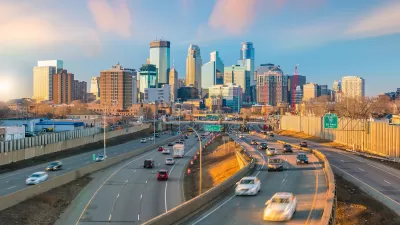Not all cities have benefited equally from congestion relief brought on by shifting commuting patterns.

This article is adapted from a piece originally published on CoworkingCafe.
When millions began working from home, many of us thought, “Finally—a break from endless traffic jams.” With WFH as the new norm, America’s roadways should have transformed into blissfully open lanes, right? Not exactly. While some cities breathed a little easier, others are still seeing bumper-to-bumper traffic. In over 80 cities across the United States, remote work has taken on a unique life of its own, sometimes clearing congestion and, in other cases, leaving roadways just as clogged as before. So, where did WFH’s traffic magic work, and where did it sputter out? Here’s how cities from coast to coast handled the remote work revolution.
Southern cities rev up for remote work, but some stay stuck in traffic
In the South, where WFH rates soared from 6 percent in 2019 to 16 percent in 2023, the effects have been varied.
For some, remote work has reshaped commutes in a big way. Take Raleigh, North Carolina. The city’s telecommuting rate more than doubled, with nearly a quarter of workers now logging in from home. As a result, Raleigh’s roads saw some serious relief, with congestion dropping by an impressive 17 percent. It’s a shift that reflects the region’s booming tech scene, where remote-friendly jobs make up a large slice of the workforce, allowing the city to dodge many of its old rush-hour headaches.
Similarly, in Tulsa, Oklahoma, WFH helped lighten the load on local roads. Remote work adoption in the city jumped from a modest 6.1 percent to almost 16 percent by 2023, and with it, congestion eased by 8 percent. For drivers in Tulsa, fewer cars at peak times meant a smoother ride home — a small but significant improvement.
Meanwhile, Jacksonville, Florida, showed how remote work can create a buffer against rising traffic. While Florida as a whole saw a 2 percent uptick in traffic, Jacksonville went against the grain. Congestion actually dropped by 6 percent, with the city’s remote work rates nearly tripling. A strong financial sector that quickly pivoted to telecommuting helped keep Jacksonville moving along, even as more cars hit the roads in other parts of the state.
Even Texas, known for its sprawling highways and big traffic, saw a few wins. San Antonio benefited from a massive 237 percent increase in remote work, particularly within its tech scene. This shift contributed to a 5 percent reduction in congestion, despite the state’s overall rise in traffic volume. For a city growing as fast as San Antonio, that’s no small feat.
But not every Southern city got off that easily. Despite substantial jumps in remote work, congestion barely budged in places like Birmingham and Louisville. Birmingham’s introduction of ride-sharing alternatives added new types of traffic to the mix, offsetting any gains from remote work. In Louisville, UPS and other logistics giants keep roadways crowded with freight trucks, making it tough for remote work to make a dent.
Baton Rouge, Louisiana, faced a similar challenge. Anchored in the energy sector, Baton Rouge saw only a slight rise in remote work from 2.8 percent to 7.9 percent. And without a major WFH boost, congestion actually worsened by 8 percent The city’s slower transition to remote work, combined with Louisiana’s 14 percent rise in state traffic volume, kept Baton Rouge’s roads far from clear.
Further east, Columbia, South Carolina, faced some of the region’s steepest congestion increases. Remote work adoption quadrupled, but with a local economy that relies heavily on manufacturing, the city’s roads saw no relief — in fact, congestion soared by 77 percent revealing the limits of WFH in places where hands-on work remains essential.
The West’s mixed WFH success: Some find relief, others are gridlocked
Out west, cities saw an interesting mix of outcomes as remote work adoption jumped. With so many tech-heavy cities embracing remote work, some managed to keep congestion in check, while others found themselves gridlocked.
Salt Lake City, for example, found a winning formula. Despite Utah’s rising overall traffic, the city saw a 16 percent dip in congestion, thanks largely to a 182 percent increase in remote work. Salt Lake’s tech and finance sectors are major players in this shift, showcasing how a WFH-friendly job market can ease up on the roads.
San Diego also reaped the benefits of remote work. Known for its beachy vibes and booming economy, San Diego saw congestion drop by 12 percent as telecommuting rates doubled, particularly in finance and information sectors. The city’s remote-friendly workforce helped it grow without turning its streets into gridlock zones—a rarity in California these days.
Even Fresno, CA, saw a notable decrease in traffic, with congestion down 10 percent. Fresno’s WFH adoption grew steadily from 5.6 percent to 10.5 percent, and California’s overall reduction in traffic volume helped clear the roads in this Central Valley city.
But not every California city felt the same relief. In San Jose, remote work adoption soared, increasing by 236 percent, yet congestion only fell by a modest 9 percent. As a major tech hub, San Jose’s in-person business demands, paired with a high-powered economy, kept more cars on the road than expected.
Meanwhile, Tucson, Arizona, showed just how challenging it can be to balance economic growth with traffic demands. Even though WFH rates doubled, congestion in Tucson jumped by 32 percent. For a city relying heavily on construction and real estate, remote work just wasn’t enough to counter the pressures of a growing economy.
In nearby Phoenix, remote work adoption nearly doubled, but congestion still jumped by 28 percent. A boom in real estate and construction has kept Phoenix’s roads busy, demonstrating that even robust WFH numbers can’t solve all of the West’s traffic woes.
Northeast cities: Some relief, but major cities stay stuck
The Northeast also saw WFH adoption rates soar, but results here varied significantly, with some smaller cities benefiting and major cities still grappling with congestion.
In Albany, New York, for instance, remote work may have given the city a lucky break. With just a modest increase in WFH rates of 31 percent, Albany’s congestion dropped by 25 percent, thanks in part to a statewide drop in traffic volume. Albany’s compact layout allowed the city to quickly reap the benefits of WFH, relieving pressure on the roads.
Buffalo saw a similar, if smaller, improvement. With WFH adoption up by 160 percent, congestion dropped by 13 percent.
But in nearby Rochester, traffic relief was more elusive. Despite a 184 percent surge in remote work, congestion held steady at 14 percent between 2019 and 2023. Rochester’s suburban population still commutes into the city for various services, keeping roadways busy even as more people worked from home.
In Massachusetts, cities like Worcester and Boston faced much steeper challenges. Congestion in Worcester surged by 60 percent, while Boston saw a similar spike of 58 percent. Although both cities saw big jumps in WFH rates, in-person industries and dwindling public transit ridership meant that congestion continued to climb, leaving their roads as packed as ever.
The Midwest: Detroit and Omaha find congestion relief, Chicago faces challenges
In the Midwest, the impact of remote work varied widely. While some cities saw major improvements, others faced gridlock.
Omaha stood out as a big winner. With congestion down by 29 percent, the city benefited from a 176 percent rise in remote work, especially in the finance sector. For Omaha, remote work wasn’t just a convenience; it was a game-changer.
Detroit saw similar success, with congestion dropping by 19 percent as Michigan’s traffic volume decreased. The auto industry’s adoption of hybrid and remote work helped keep Detroit’s roads relatively open, showing how an industry shift can reshape a city’s streets.
St. Louis, on the other hand, saw no such improvements. Remote work adoption surged by an astonishing 262 percent, yet congestion remained steady at 14 percent. With Missouri’s overall traffic growth, St. Louis’s roads stayed as crowded as ever.
Milwaukee and Chicago, meanwhile, faced their own challenges. Milwaukee’s congestion jumped by 38 percent, and Chicago saw a similar increase of 36 percent. Both cities have major industrial and freight sectors, and a drop in public transit ridership meant more cars hit the road, keeping congestion high despite WFH gains.
What the data says about remote work and traffic
As we look across these 83 cities, it’s clear that remote work has brought relief to some areas while leaving others just as crowded as before. The cities seeing the most benefit from WFH were those with a flexible, remote-friendly workforce and a supportive economic structure. For fast-growing cities, or those with heavy industry or logistics, WFH alone wasn’t enough to solve congestion.
Telecommuting has no doubt reshaped our roadways, but it’s clear that tackling urban congestion will require more than just a remote work policy. As cities continue to grow and evolve, the future of urban mobility will rely on creative solutions, from smarter infrastructure to updated transit options, to keep America’s cities moving in this new, work-from-anywhere world.


Andreea Neculae is a creative writer at CoworkingCafe and CoworkingMag, with a passion for bringing human-interest stories to light. From research on coworking trends and the real estate market, Andreea’s work was covered in The Business Journals, The New York Times and Forbes.

Planetizen Federal Action Tracker
A weekly monitor of how Trump’s orders and actions are impacting planners and planning in America.

Maui's Vacation Rental Debate Turns Ugly
Verbal attacks, misinformation campaigns and fistfights plague a high-stakes debate to convert thousands of vacation rentals into long-term housing.

San Francisco Suspends Traffic Calming Amidst Record Deaths
Citing “a challenging fiscal landscape,” the city will cease the program on the heels of 42 traffic deaths, including 24 pedestrians.

Defunct Pittsburgh Power Plant to Become Residential Tower
A decommissioned steam heat plant will be redeveloped into almost 100 affordable housing units.

Trump Prompts Restructuring of Transportation Research Board in “Unprecedented Overreach”
The TRB has eliminated more than half of its committees including those focused on climate, equity, and cities.

Amtrak Rolls Out New Orleans to Alabama “Mardi Gras” Train
The new service will operate morning and evening departures between Mobile and New Orleans.
Urban Design for Planners 1: Software Tools
This six-course series explores essential urban design concepts using open source software and equips planners with the tools they need to participate fully in the urban design process.
Planning for Universal Design
Learn the tools for implementing Universal Design in planning regulations.
Heyer Gruel & Associates PA
JM Goldson LLC
Custer County Colorado
City of Camden Redevelopment Agency
City of Astoria
Transportation Research & Education Center (TREC) at Portland State University
Jefferson Parish Government
Camden Redevelopment Agency
City of Claremont





























